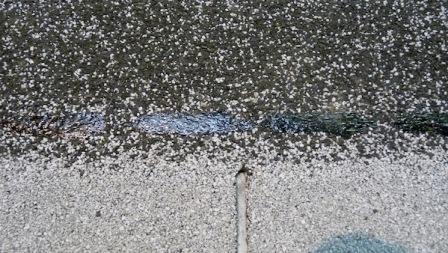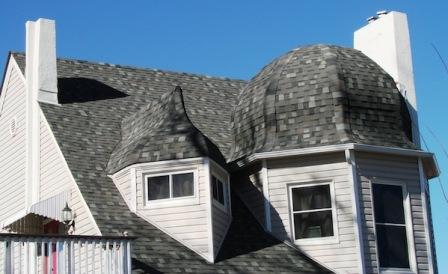Mastering Roof Inspections: Asphalt Composition Shingles, Part 27
by Kenton Shepard and Nick Gromicko, CMI®
The purpose of the series “Mastering Roof Inspections” is to teach home inspectors, as well as insurance and roofing professionals, how to recognize proper and improper conditions while inspecting steep-slope, residential roofs. This series covers roof framing, roofing materials, the attic, and the conditions that affect the roofing materials and components, including wind and hail.
Substrate Holding Power
Deteriorated roof decks can lose a lot of their power to hold fasteners. Decay is one of the most common causes. If you see shingle loss due to fastener withdrawal, look at the condition of the underlying roof deck, especially if the affected area is vulnerable to leakage, such as near a roof penetration.
Checking for Proper Fastening
A few jurisdictions require home inspectors to confirm proper fastening of shingles. You are not required to do this by the InterNACHI Standards of Practice.
Confirmation is impractical for two reasons. First, fastening schedules vary with different models of shingles. As an inspector, you won’t know the fastening requirements unless you identify the manufacturer and model of the shingles on the roof, and research the fastening requirements. Maybe that information will still be available somewhere, but maybe not. Trying to find it may use up a lot of your time that your client may or may not pay for. Second, the only way to confirm proper fastening of an entire roof is to break the bonds of all the adhesive strips on the roof, and that will damage the roof. Breaking the bonds would seriously compromise the wind resistance of the roof and could easily damage it permanently.
If you want to check for proper fastening in a representative number of places, after breaking the bond, you’ll need to hand-seal any affected shingles to help ensure that they fully re-bond. At best, it will take time for any bonds you break to re-seal. If the weather is cold, re-sealing may take months.
Before they bond, shingles have much lower wind resistance, so if you break the bonds of shingles and they blow off, you may be asked to pay for repairs. If a big wind comes up and blows the adhesive strip or roof cement full of dust and debris, the shingle will never fully bond.
It’s better if you don’t break the bonds of any shingles. If you do, you may be liable for damage caused by reduced wind resistance.
Hand-Sealing Shingles
Asphalt shingles are hand-sealed by applying quarter-size spots of roofing cement beneath shingle tabs. The cement is applied with a caulking gun, and the location of these spots can vary with shingle type.
On 3-tab shingles, cement spots should be applied under the corner of each tab located such that when the tab is pressed into place, the cement reaches the tab edge but is not exposed.
Asphalt shingles may need to be hand-sealed to address many issues, including a failed adhesive bond. The bond of the adhesive strips may be weak or can fail completely. This can happen for a number of reasons, such as:
- cold weather. In order for the initial bond to take place, weather has to be warm enough to soften the adhesive strip. Shingles installed during cold times of the year may take months to fully bond. Cold weather may also prevent shingles that have been hand-sealed from bonding;
- poor-quality adhesive. Because there are no standards for adhesive strip bond-strength, it can vary widely among shingles produced by different manufacturers. A shingle with poor-quality adhesive might bond adequately when it’s installed on a roof in California, but might bond poorly installed on a roof in North Dakota;
- inadequate adhesive amount. Since there are no standards for adhesive strips, manufacturers may not apply enough adhesive, leaving shingles with a weak bond;

Compare the adhesive strip on this 20-year shingle…

…with the asphalt on this 50-year shingle.
The extra weight of multi-layer shingles will help them to bond fully.
- debris. If debris is blown into the adhesive strips, either before shingles have a chance to bond initially, or after the bonds were broken by the wind, shingles may never fully bond;

- steep roof pitch. When roof pitches exceed 21:12, such as mansard roofs, the weight of the shingle alone may not be enough to fully bond the adhesive strips. This can result in shingle blow-off;

Roofs with unusual shapes may have the same problem.
A couple of examples are the conical roof of this turret and…

…the helmet-shape roofs of this home.

- rake edges. The rake edges of roofs exposed to high winds are especially vulnerable to uplift forces. Hand-sealing will help keep the roof in these areas intact. This is not a requirement, but if you see many poorly bonded, damaged shingles along rakes, you might recommend that they be hand-sealed; and
- valleys. When shingles are inadequately sealed at valleys, water running down one roof slope may gain enough momentum to run up beneath the shingles on the opposite slope. Depending on the quality of the installation, shingles cut parallel to the centerline of the valley may need to be hand-sealed along the valley.
Checking Shingle Bond
On different slopes, you should lift slightly on shingles to make sure they’re bonded. Check shingles on different parts of each slope, since the direction each slope faces may affect the quality of the bond.
Also, check parts of the roof that may be shaded by trees or geological features, such as mountains. Homes in canyons and gulleys get much less sun during the day than those in the open.
Don’t go breaking the bonds of a lot of shingles! If you break the bond of even a weakly bonded shingle, you reduce its wind resistance even further and increase the chances of wind damage.
If you find shingles with adhesive strips that are weakly bonded, or that are not bonded at all, describe that condition in your report. Information should include whether the problem is limited to certain areas of the roof, or is a general problem across the entire roof.
You are not required to identify the cause of bond failure, but if you’re confident that you have accurately identified the cause, you can include that information in the report. You can also simply recommend correction by a qualified contractor. The correction for failed adhesive strips is to seal them by hand.
**************************************************
Learn how to master a roof inspection from beginning to end by reading the entire InterNACHI series: Mastering Roof Inspections.
Take InterNACHI’s free, online Roofing Inspection Course
Mastering Roof Inspections
Roofing Underlayment Types
Inspecting Underlayment on Roofs
Fall-Arrest Systems
Roofing (consumer-targeted)
More inspection articles like this

